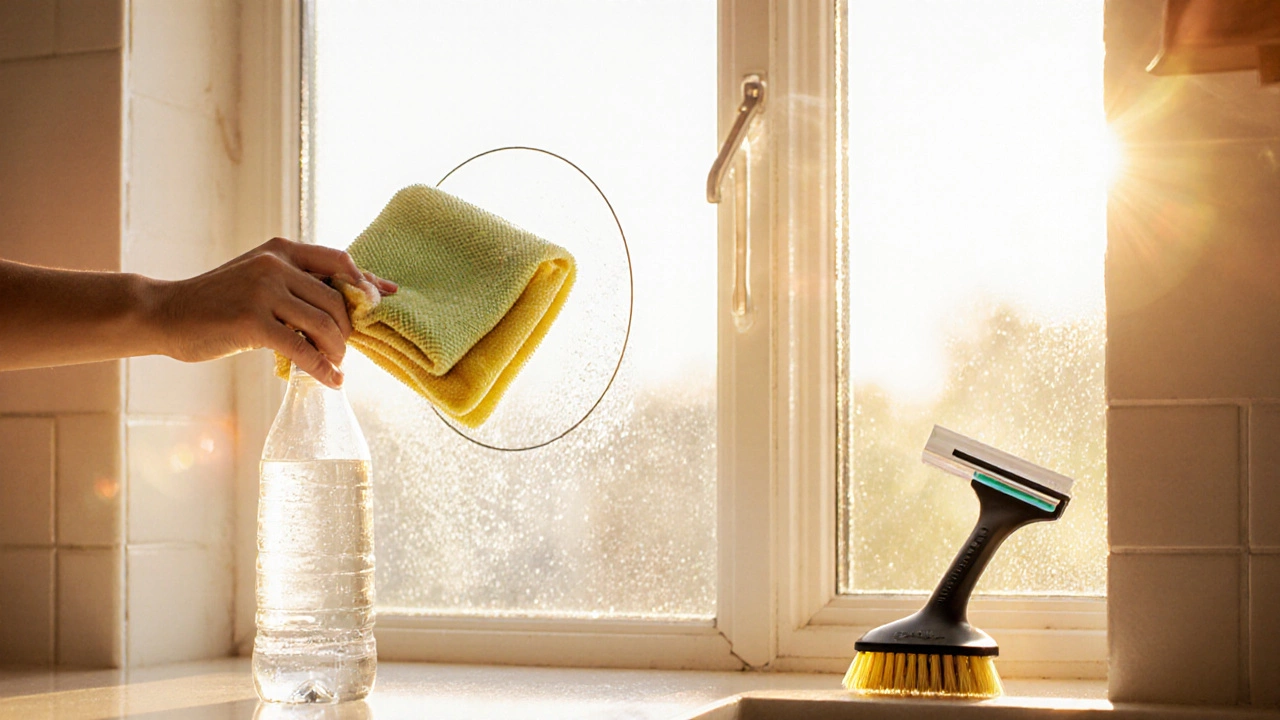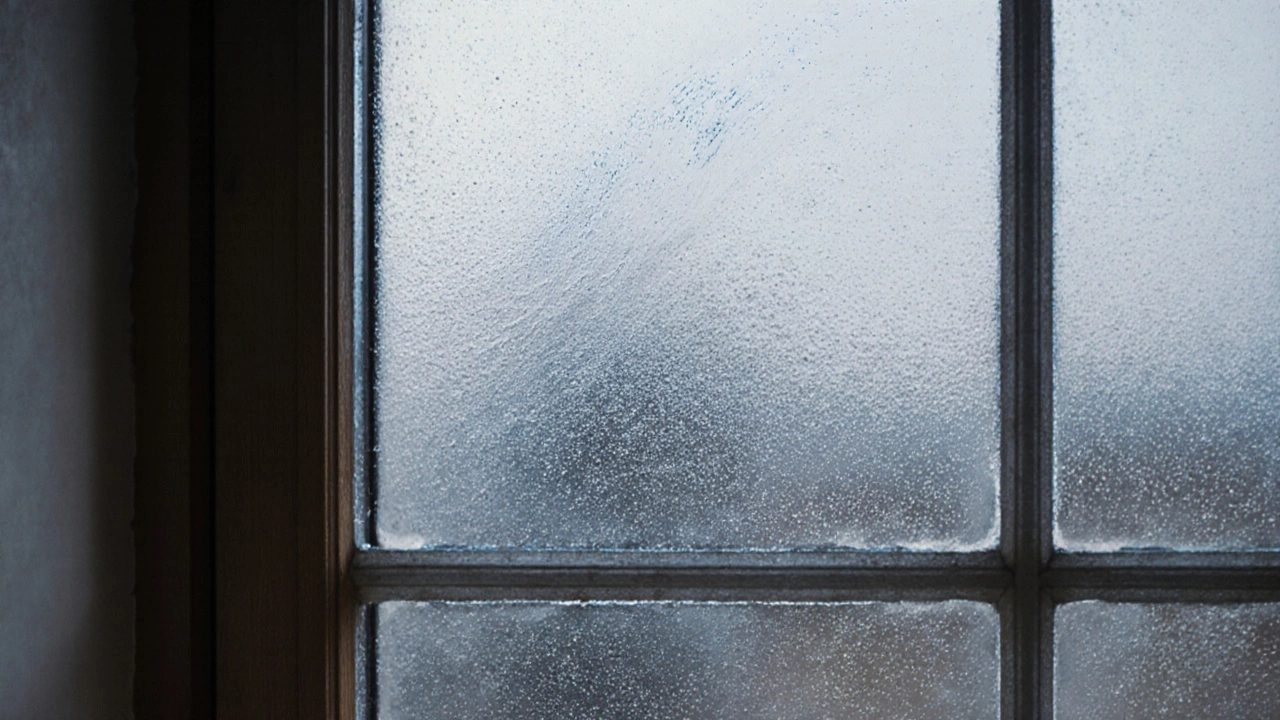Window Cleaning Solution Calculator
Solution Details:
Vinegar & Water
1 part vinegar to 2 parts water. Great for everyday grime and hard-water spots.
Lemon Juice & Water
1 part lemon juice to 2 parts water. Natural acidity with a fresh scent.
Alcohol & Water
1 part alcohol to 3 parts water. Fast-drying and streak-free finish.
When a thin dirt film a hazy residue that forms on glass surfaces from airborne particles and mineral deposits coats your windows, the view gets murky and cleaning feels impossible. This guide shows you how to remove dirt film from windows quickly, safely, and without harsh chemicals.
Quick Take
- Start with a vinegar‑water mix for everyday grime.
- Use a microfiber cloth to trap dust before applying liquid.
- For stubborn mineral streaks, try a diluted citric solution or an ammonia‑free commercial cleaner.
- Finish with a squeegee at a 45° angle to avoid water marks.
- Rinse with distilled water on windy days to minimize re‑deposition.
Why Dirt Film Sticks to Windows
Understanding the cause helps you choose the right weapon. Dirt film is a blend of:
- Fine dust particles that settle on the glass surface.
- Oil residues from cooking, candles, or outdoor pollution.
- Mineral deposits left by hard water, especially after rain.
These components create a semi‑transparent layer that refracts light, making the glass look dull. If you try to wipe it away with a dry rag, you simply spread the film around and may even scratch the pane.
Gathering the Right Tools
Before you start, assemble a small kit. Each item has a specific role and is proven by cleaning professionals across the UK.
- Microfiber cloth high‑loft, lint‑free fabric that traps particles instead of redepositing them - one for dry dusting, another for wet work.
- Squeegee rubber‑edged blade, 12‑inch length, ideal for residential windows - ensures a streak‑free finish.
- Spray bottle (glass‑grade) for mixing solutions.
- Soft‑bristled brush for corners and frames.
- Distilled water for a final rinse (prevents mineral re‑deposit).
Homemade Cleaning Solutions - The Eco‑Friendly Approach
Most household items work wonders without the chemicals found in commercial cleaners. Below is a quick‑reference table comparing three popular DIY mixes.
| Ingredient | Ratio | Strengths | Best For |
|---|---|---|---|
| White vinegar | 1 part vinegar : 2 parts water | Cuts grease, dissolves mineral film | Everyday grime and hard‑water spots |
| Lemon juice | 1 part lemon juice : 2 parts water | Natural acidity, pleasant scent | Light film on north‑facing windows |
| Isopropyl alcohol (70%) | 1 part alcohol : 3 parts water | Fast evaporation, streak‑free | High‑traffic panes where drying speed matters |
All three solutions are safe for double‑glazed units and won’t damage frame finishes. If you’re allergic to citrus, stick with vinegar or alcohol.

Step‑by‑Step Cleaning Process
- Dry dust first. Take a clean microfiber cloth and wipe the window in a vertical motion. This removes loose particles that would otherwise create scratches.
- Apply the chosen solution. Spray the vinegar‑water mix onto the glass, covering the entire surface. Let it sit for 30 seconds; the acidity loosens the film. \n
- Agitate gently. Use a soft‑bristled brush or a second microfiber cloth in a circular motion. Focus on corners where dust accumulates.
- Clear with a squeegee. Starting at the top left, pull the squeegee horizontally across the pane. Wipe the blade with a clean cloth after each pass to avoid streaks.
- Rinse and dry. Lightly mist distilled water over the glass, then pat dry with a fresh microfiber towel. This final rinse removes any lingering acid residue.
- Inspect in daylight. Walk around the room and look at the windows from different angles. If you spot a stray streak, repeat the squeegee step with a tiny amount of alcohol for quick evaporation.
Following these six steps gives you a crystal‑clear view without resorting to abrasive pads or harsh chemicals.
Dealing with Stubborn Hard‑Water Stains
When mineral build‑up forms a cloudy veil, the regular vinegar mix may need a boost. Try one of these proven techniques:
- Citric acid paste. Mix two teaspoons of citric powder with a tablespoon of water. Apply to the stain, let sit for five minutes, then wipe clean.
- Ammonia‑free commercial cleaner. Look for products labelled “streak‑free” and “no‑ammonia”. They contain surfactants that break down calcium deposits.
- Rain‑shield treatment. After a deep clean, spray a rain‑repellent (silicone‑based) on the exterior pane. It creates a hydrophobic layer that discourages future mineral adhesion.
Always wear gloves when handling acidic powders and ensure good ventilation if you choose a commercial cleaner.
Maintenance Tips to Keep Dirt Film at Bay
Prevention saves you time and money. Adopt these simple habits:
- Wipe windows with a dry microfiber cloth each month to remove dust before it bonds.
- Use distilled water for final rinses on rainy days; tap water often leaves mineral trails.
- Install over‑the‑window screens that filter out pollen and grit.
- Schedule a deep clean every 3‑4months, especially after long periods of high humidity.
- If you have indoor plants, keep them a few feet away from glass to reduce mist‑driven residue.
These practices turn a quarterly chore into a quick touch‑up, preserving the sparkle you worked hard for.
Common Mistakes and How to Avoid Them
Even seasoned cleaners slip up. Here are pitfalls you might encounter and the fix.
- Using newspaper. It leaves ink smudges on modern low‑emissivity glass.
- Cleaning in direct sunlight. Heat causes the cleaning solution to dry too fast, leaving streaks.
- Skipping the dry‑dust step. Abrasive particles can scratch the pane during the wet phase.
- Re‑using a dirty squeegee blade. Residue builds up and creates lines across the glass.
By keeping these warnings in mind, you’ll achieve a professional finish every time.
Frequently Asked Questions
Can I use regular tap water for the final rinse?
Tap water often contains calcium and magnesium, which can re‑deposit as a thin film. Distilled or demineralised water is the safest choice for a streak‑free finish.
Is vinegar safe for tinted or low‑e windows?
Yes. A diluted vinegar solution (1:2) is gentle enough for most coatings. Always test a small corner first, especially on older tinted glass.
How often should I clean my windows to prevent dirt film?
A light dust‑off monthly and a deep clean every three to four months keeps the film from building up. Adjust frequency if you live in a high‑pollution area.
What’s the best way to clean hard‑to‑reach corner panes?
Attach a small microfiber swab to a flexible telescope pole. Spray the cleaning solution onto the swab, then wipe gently before using the squeegee on the main surface.
Can commercial ammonia‑based cleaners damage my windows?
Ammonia can etch certain low‑e coatings over time. Opt for ammonia‑free alternatives or stick with vinegar‑based mixes for regular maintenance.
